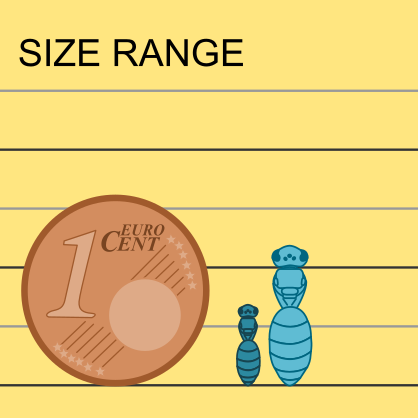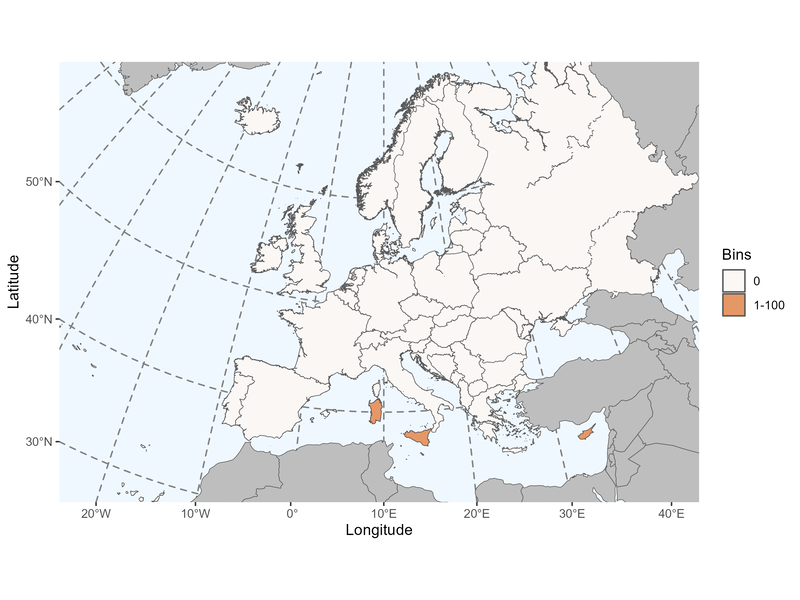Author: Morawitz, 1895
|
Type species: Tarsalia hirtipes Morawitz, 1895, monobasic.
|
Clade: Anthophila
Family: Apidae SubF: Anthophorinae Tribe: Ancylini |
|
Distinctive traits
|
Pictures of distinctive traits (yet to come, if you have some, please contact us.)
|
Morphologically close genera and how to distinguish them:
Ancyla has short mouthparts (glossa and palpi) similar to those of Melittidae, and a flat clypeus.
- Tarsalia - Ancyla
Ancyla has short mouthparts (glossa and palpi) similar to those of Melittidae, and a flat clypeus.
General comments on Tarsalia species identification
With only two species, Tarsalia specimens can be identified to the species level on the basis of size (T. hirtipes = 11-12mm, T. ancyliformis=7-8mm), colour of the clypeus in females (dark in T. hirtipes, yellow in T. ancyliformis) and apical margin of S6 in females (deeply notched, bidentate in T. hirtipes, not in T. ancyliformis). However, the genus identification has to be performed with care, since Tarsalia females can be easily confused with Eucera or Ancyla species.
With only two species, Tarsalia specimens can be identified to the species level on the basis of size (T. hirtipes = 11-12mm, T. ancyliformis=7-8mm), colour of the clypeus in females (dark in T. hirtipes, yellow in T. ancyliformis) and apical margin of S6 in females (deeply notched, bidentate in T. hirtipes, not in T. ancyliformis). However, the genus identification has to be performed with care, since Tarsalia females can be easily confused with Eucera or Ancyla species.
List of the 2 Tarsalia species found in Europe (Ghisbain et al. 2023):
Tarsalia ancyliformis Popov, 1935
Tarsalia hirtipes Morawitz, 1895
Species identification:
T. hirtipes:
- 10-12mm.
Females: clypeus dark, interior part of posterior tibia with black hairs.
Males: antennal segment 3 1.5 longer than wide, as long as the following ones; apical margin of S6 deeply notched, bidentate.
T. ancyliformis:
- 7-8mm.
Females: clypeus yellow, interior part of posterior tibia without black hairs. At most black hairs on the basitarsus
Males: antennal segment 3 as long as wide; apical margin of S6 not bidentate, barely notched.
Tarsalia ancyliformis Popov, 1935
Tarsalia hirtipes Morawitz, 1895
Species identification:
T. hirtipes:
- 10-12mm.
Females: clypeus dark, interior part of posterior tibia with black hairs.
Males: antennal segment 3 1.5 longer than wide, as long as the following ones; apical margin of S6 deeply notched, bidentate.
T. ancyliformis:
- 7-8mm.
Females: clypeus yellow, interior part of posterior tibia without black hairs. At most black hairs on the basitarsus
Males: antennal segment 3 as long as wide; apical margin of S6 not bidentate, barely notched.
References with identification keys for some of the species:
- Warncke, K. 1979. Beiträge zur Bienenfauna des Iran : 10. Die Gattung Ancyla LEP., mit einer Revision der Bienengattung Ancyla LEP. Boll. Mus. Civ. Stör. Nat., Venezia 30 : 183-19
Page contributors:
You noticed a mistake? You have a suggestion to improve this page?
Don't keep it to yourself, contact us and become a contributor to IDmyBee!
References used to write this page:
- Adrien Perrard (Dec. 2023)
- Adrien Perrard (Dec. 2019)
You noticed a mistake? You have a suggestion to improve this page?
Don't keep it to yourself, contact us and become a contributor to IDmyBee!
References used to write this page:
- Bossert, S., E. Murray, E.A.B. Almeida, S. Brady, B. Blaimer, B.N. Danforth (2018). Combining transcriptomes and ultraconserved elements to illuminate the phylogeny of Apidae. Molecular Phylogenetics and Evolution 130 (2019): 121–131
- Ghisbain, G., Rosa, P., Bogusch, P., Flaminio, S., Le Divelec, R., Dorchin, A., Kasparek, M., Kuhlmann, M., Litman, J., Mignot, M., Müller, A., Praz, C., Radchenko, V.G., Rasmont, P., Risch, S., Roberts, S.P.M., Smit, J., Wood, T.J., Michez, D. & Reverte, S. (2023). The new annotated checklist of the wild bees of Europe (Hymenoptera: Anthophila). Zootaxa, 5327(1), 1-147.
- Michener, C.D. 2007. The Bees of the World, 2nd Edition. The John Hopkins University Press, Baltimore.
- Michez D., Rasmont P., Terzo, M., Vereecken, N. 2019. Abeilles d'Europes. Hymenoptères d'Europes, Volume 1. N.A.P. Editions.
- Nieto, A., Roberts, S. P., Kemp, J., Rasmont, P., Kuhlmann, M., García Criado, M., ... & Michez, D. 2014. European red list of bees. Luxembourg: Publication Office of the European Union, 98. (IUCN 2014)
- Rasmont, P., Devalez, Jelle, Pauly, A., Michez, D. & Radchenko, V.G. 2017. Addition to the checklist of IUCN European wild bees (Hymenoptera: Apoidea). Annales de la Société entomologique de France 53: 17-32.



